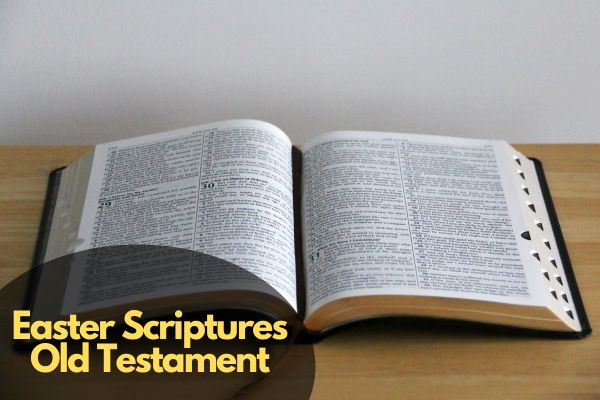Easter Scriptures Old Testament; Easter, a significant Christian holiday commemorating the resurrection of Jesus Christ, finds its roots deeply embedded in the Old Testament Scriptures. These ancient texts, revered by Jews and Christians alike, foreshadow the events leading to Easter Sunday, offering profound insights into the theological significance of this sacred occasion.
Exploring the Easter Scriptures in the Old Testament unveils a shade of prophecies, symbols, and narratives that enrich our understanding of the Easter story and its profound spiritual implications.
Easter Scriptures Old Testament
Easter, the cornerstone of the Christian faith, commemorates the resurrection of Jesus Christ from the dead, symbolizing victory over sin and death. While the New Testament accounts provide detailed narratives of this pivotal event, the Old Testament lays a profound foundation for understanding the significance of Easter.
Through prophecies, symbols, and typologies, the Old Testament foreshadows the redemptive work fulfilled in Jesus Christ. Here, we will look into Old Testament scriptures that anticipate the essence of Easter
1. Genesis 3:15: The promise of a Savior who will crush the serpent’s head, foreshadowing Christ’s victory over sin and Satan.
2. Exodus 12:13: The Passover lamb’s blood sparing the Israelites from death parallels Jesus’ sacrificial death, becoming the ultimate Passover Lamb.
3. Isaiah 53: This chapter vividly portrays the suffering servant, anticipating Jesus’ sacrificial death and the atonement for humanity’s sins.
4. Psalm 22: Describes the agony of crucifixion and the forsakenness Jesus experienced on the cross, echoing Christ’s cry, “My God, my God, why have you forsaken me?”
5. Psalm 16:10: Foretells the resurrection with the promise that God will not abandon his holy one to decay, pointing to Jesus’ triumph over death.
6. Isaiah 25:8: Prophesies the defeat of death and the wiping away of tears, reflecting the hope of resurrection and eternal life through Christ.
7. Jonah 1:17-2:10: Jonah’s time in the belly of the fish prefigures Jesus’ burial and resurrection after three days.
8. Zechariah 9:9: Foretells the coming of a king, humble and riding on a donkey, fulfilled in Jesus’ triumphal entry into Jerusalem.
9. Isaiah 26:19: Promises the resurrection of the dead, awakening to sing praises, anticipating Easter’s celebration of new life in Christ.
10. Psalm 118:22-24: The rejected stone becoming the cornerstone signifies Jesus’ rejection and subsequent exaltation through his resurrection.
11. Hosea 6:2: Speaks of revival after two days, pointing to Christ’s resurrection on the third day and the spiritual renewal it brings.
12. Isaiah 53:11: Describes the servant’s justification of many through his righteous suffering, prefiguring Jesus’ redemptive work on the cross.
13. Job 19:25-27: Job’s declaration of faith in a Redeemer who will stand upon the earth mirrors the hope Christians have in Jesus’ return and final victory.
14. Daniel 12:2: Foreshadows the resurrection of both the righteous and the wicked, emphasizing the hope of eternal life for believers.
15. Psalm 30:5: Affirms that weeping may endure for a night, but joy comes in the morning, symbolizing the transition from Good Friday’s sorrow to Easter Sunday’s joy.
16. Isaiah 50:6: Portrays the servant enduring beatings and insults, mirroring Jesus’ sufferings before his crucifixion.
17. Isaiah 52:13-53:12: The suffering servant’s vicarious sacrifice and eventual exaltation serve as a profound portrait of Christ’s redemptive mission.
18. Exodus 15:13: The promise of God’s steadfast love leading the redeemed people echoes the salvation and deliverance achieved through Jesus’ death and resurrection.
19. Isaiah 2:2-5: Envisions a time when all nations will stream to the mountain of the Lord, finding peace and salvation—a foreshadowing of the gospel’s universal message.
20. Exodus 3:2-6: The burning bush symbolizes God’s presence and holiness, anticipating the divine presence manifest in Jesus Christ.
21. Isaiah 7:14: The prophecy of a virgin conceiving and bearing a son named Immanuel finds fulfillment in Jesus’ miraculous birth and his identity as “God with us.”
22. Genesis 22:1-14: Abraham’s willingness to sacrifice his son Isaac prefigures God’s sacrificial offering of his own Son for the redemption of humanity.
23. Numbers 21:8-9: The bronze serpent lifted up in the wilderness, bringing healing to those who looked upon it, symbolizes Jesus’ atoning work on the cross.
24. Exodus 14:13-14: God’s deliverance of Israel through the parting of the Red Sea prefigures the ultimate deliverance from sin and death through Jesus Christ.
25. Psalm 69:21: The offering of vinegar to drink in times of suffering anticipates Jesus’ experience on the cross when he is given sour wine.
26. Isaiah 35:4-6: The promise of God coming with vengeance to save his people includes the restoration of sight, hearing, and mobility—mirroring Jesus’ healing ministry.
27. Jeremiah 31:31-34: Foretells the new covenant God will make, written on the hearts of his people, pointing to the spiritual renewal brought by Christ’s sacrifice.
28. Isaiah 9:6-7: The prophecy of a child born to us, called Wonderful Counselor, Mighty God, Everlasting Father, Prince of Peace, finds fulfillment in Jesus Christ.
29. Exodus 16:4: God providing manna in the wilderness prefigures Jesus’ declaration as the bread of life, sustaining and nourishing believers spiritually.
30. Genesis 22:8: Abraham’s prophetic statement, “God will provide for himself the lamb,” foreshadows Jesus as the Lamb of God who takes away the sin of the world.
Conclusion
The Easter Scriptures of the Old Testament serve as a timeless testament to the divine orchestration of salvation history. Through prophetic utterances, typological representations, and historical accounts, these sacred texts lay the groundwork for the climactic events of Easter, illuminating the redemptive plan of God for humanity.
As we probe into these ancient passages, we encounter a profound continuity between the Old and New Testaments, affirming the faithfulness of God and the fulfillment of His promises in the resurrection of Jesus Christ.








